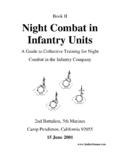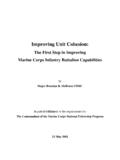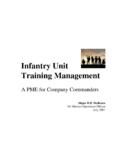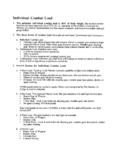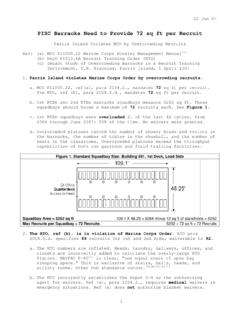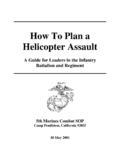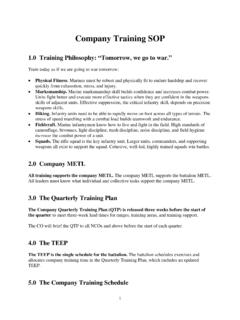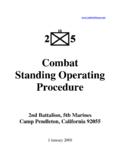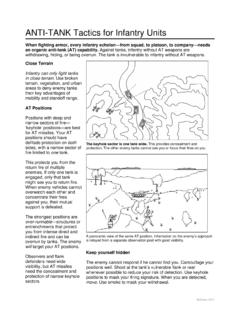Transcription of www.2ndbn5thmar.com Tank-Infantry SOP
1 Tank-Infantry SOP Squad Version September 2005 Contributing Editors: This SOP is based on a 2000 AAR and SOP written by Capt Michael DelPalazzo. Lt Elliot Ackerman built and edited the entire document adding his extensive experience as a platoon commander working with tanks in Iraq. Tank company commanders Capt Michael Skaggs and Capt Robert Bodisch contributed their comments, training handouts, and AARs from tank operations in Iraq. Maj Kevin Collins, Maj Tye Wallace, LtCol David Davenport, Maj David Vickers, and Lt Paul Chase all contributed comments and insights. Maj Brendan McBreen, Editor Table of Contents 100 Scope 101 Tasks 102 Options for Organization 103 Threat 200 Protection Tasks 201 Protect a Stationary Tank 202 Protect a Firing Tank 203 Protect a Tank Fighting Position 204 Protect a Moving Tank 205 Clear Danger Areas 206 Suppress Enemy AT Weapons 300 Observation Tasks 301 Designate Targets 302 Spot Friendly Units 303 Guide Tank Movement 304 Overcome Obstacles 305 Find Mines and Improvised Explosive Devices (IEDs)
2 400 Tank-Infantry Team Coordination 401 Communications 402 Weapons and Equipment 403 Riding on the Tank 404 Training 405 Platoon Integration 500 Appendices A Simple Target Designation & Advanced Target Designation B Tank-Infantry Fight in Fallujah C Tank-Infantry References 100. Scope 1. This SOP describes the actions of the Tank-Infantry team at the squad level. The focus of this SOP is on the dedicated dismounted security tasks that small infantry units provide tanks in close urban terrain against an enemy with an AT capability.
3 2. This SOP describes how tanks fight alongside a single foot-mobile infantry unit . All tactics, techniques, and procedures (TTPs) describe the actions of one tank and one small infantry unit in the context of tank section and rifle platoon operations. Figure 100-1. The Tank-Infantry team. The SOP does NOT describe tank tactics. This SOP does NOT describe how tank platoons or tank companies integrate and fight with infantry companies or battalions. This SOP does NOT describe mechanized vehicle and tank coordination. This SOP does NOT discuss tank-on-tank combat. This SOP does NOT discuss combat in open terrain where a Tank-Infantry team would likely NOT be integrated at the platoon level.
4 This SOP does NOT include any tank-specific data. No specific tank is mentioned. Tank infantry training must include specifics on tank capabilities and limitations. 3. Abbreviations used in this SOP: AT Anti-tank OP Observation Post ATGM Anti-tank Guided Missile RPG Rocket Propelled Grenade LOS Line Of Sight TC Tank Commander MG Machinegun TRP Target Reference Point 101. Tasks 1. The tank helps the infantry unit fight. The infantry unit protects the tank. The infantry unit helps the tank fight. The infantry unit can see and hear what the tank crew cannot.
5 As the eyes and ears of the tank, the infantry unit s observations increase the situational awareness of the tank. This relationship is mutually beneficial the tank crew is given targets by the infantry unit and the infantry unit gains firepower. The infantry unit and the tank crew must be in constant communication to enhance each other s situational awareness. The infantry unit provides overwatch and designates targets for the tank. The infantry unit moves forward to examine and clear terrain, obstacles, and enemy threats for the tank. 2. The security that the infantry unit provides for the tank is critically important when tanks are operating in close terrain against an enemy with AT weapons.
6 Security is crucial when the enemy location is unknown, when visibility is poor, during retrograde operations when the enemy is closing, or during offensive movement, when tanks need protection to advance in close terrain. 3. An infantry unit supported by tanks needs specific training on the collective skills needed to protect the tank and help the tank fight. They must be proficient in the following: Protect a Stationary Tank Protect a Firing Tank Protect a Tank Fighting Position Protect a Moving Tank Clear Danger Areas Suppress Enemy AT Weapons Designate Targets Spot Friendly Units Guide Tank Movement Overcome Obstacles 102. Options for Organization 1.
7 To form a combined-arms Tank-Infantry team, a tank platoon or tank section is placed in Direct Support (DS) of an infantry company. tanks roll to Co Tac and operate as a subordinate element of the company. The company may also be reinforced with other types of units. Figure 102-1. infantry Company reinforced with a DS Tank Section or Tank Platoon. 2. The company commander can then assign a tank section in DS to one infantry platoon. tanks roll to Platoon Tac and operate as a subordinate element of the platoon. tanks may be assigned to a platoon for a very short time to support a single tactical evolution. The platoon may also be reinforced with other types of weapons units or engineer units.
8 Figure 102-2. infantry Platoon reinforced with a DS Tank Section. Sections of two tanks are almost never split. tanks fight as pairs for reasons of overwatch, mutual support, recovery, internal and external ammunition transfers, and tactical employment. 3. The platoon commander has a number of options to organize and fight his reinforced platoon: a. The platoon commander can attach a dedicated infantry tank security squad to the tank section, one reinforced team to each tank. This organization guarantees full-time security for each tank, establishes habitual relationships and fixed comm links, and enables the tank security units to focus on developing tank knowledge and refining Tank-Infantry SOPs.
9 Short squads are ideal for this mission. Attached mortarmen, machinegunners, assaultmen, or engineers should NOT be assigned to protect the tanks except as part of a rifle squad. However, the remaining two-squad platoon is now significantly less flexible and tactically limited. Figure 102-3. Tank security squad, attached to tank section, attaches one team to each tank. Figure 102-4. Single tank security team attached to tank section. b. The platoon commander can marry squads with tanks on a rotating basis. This is the recommended technique. The squad operates together with the tanks for a specific tactical mission. Over the course of an engagement, as squads rotate missions and locations, the tanks will work with each of the three squads.
10 The benefits of tactical flexibility far exceed the benefits of habitual relationships. Figure 102-5. Tank support to one squad rotates among squads. c. A squad leader, working with tanks , can assign one fire team the tank security mission. One element of the squad is then continuously focused on tank security, communication, and cooperation. Figure 102-6. Squad assigns one team the tank security mission. 4. Every infantryman must understand the fundamentals of providing security for a tank. infantry leaders must know how to employ tanks . The chaotic nature of the urban battlefield will not allow tanks to work exclusively with one unit .

